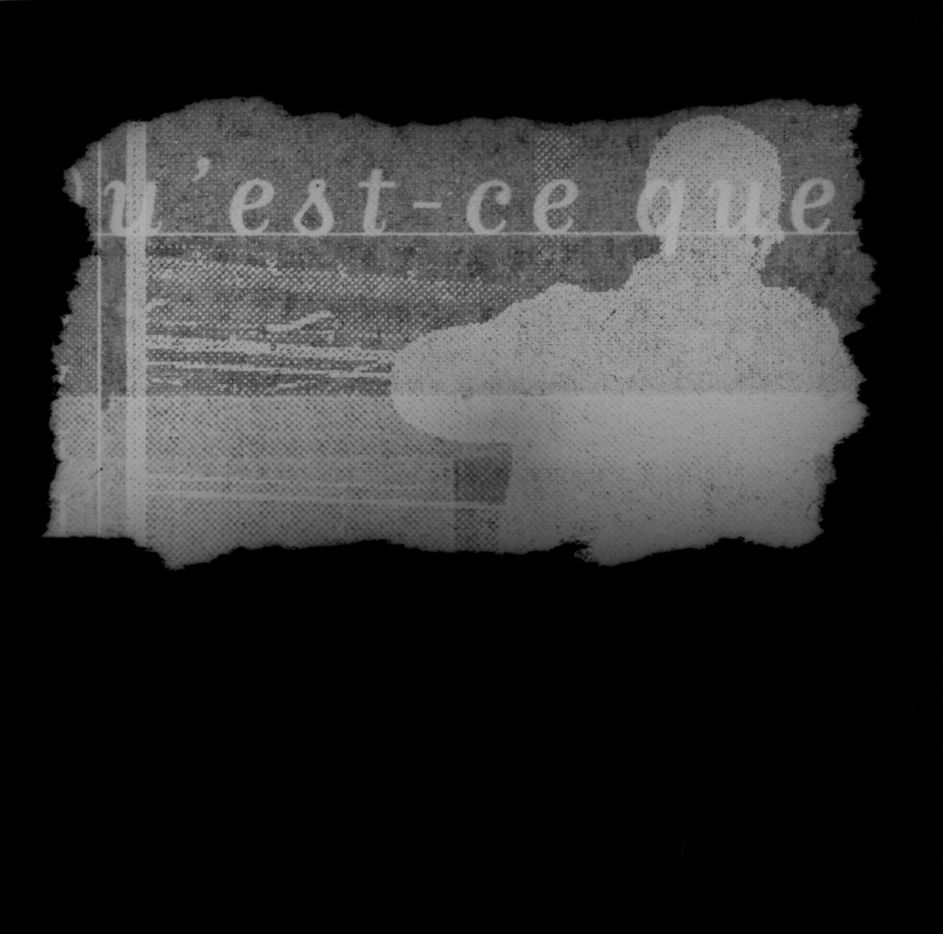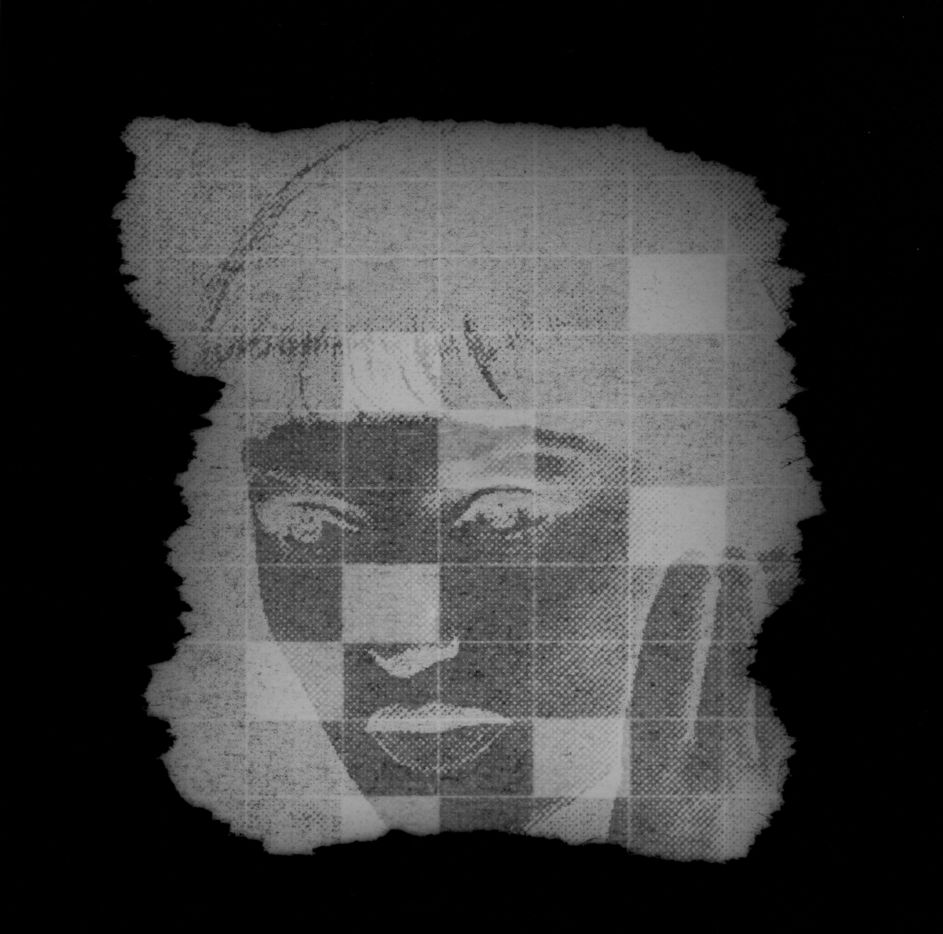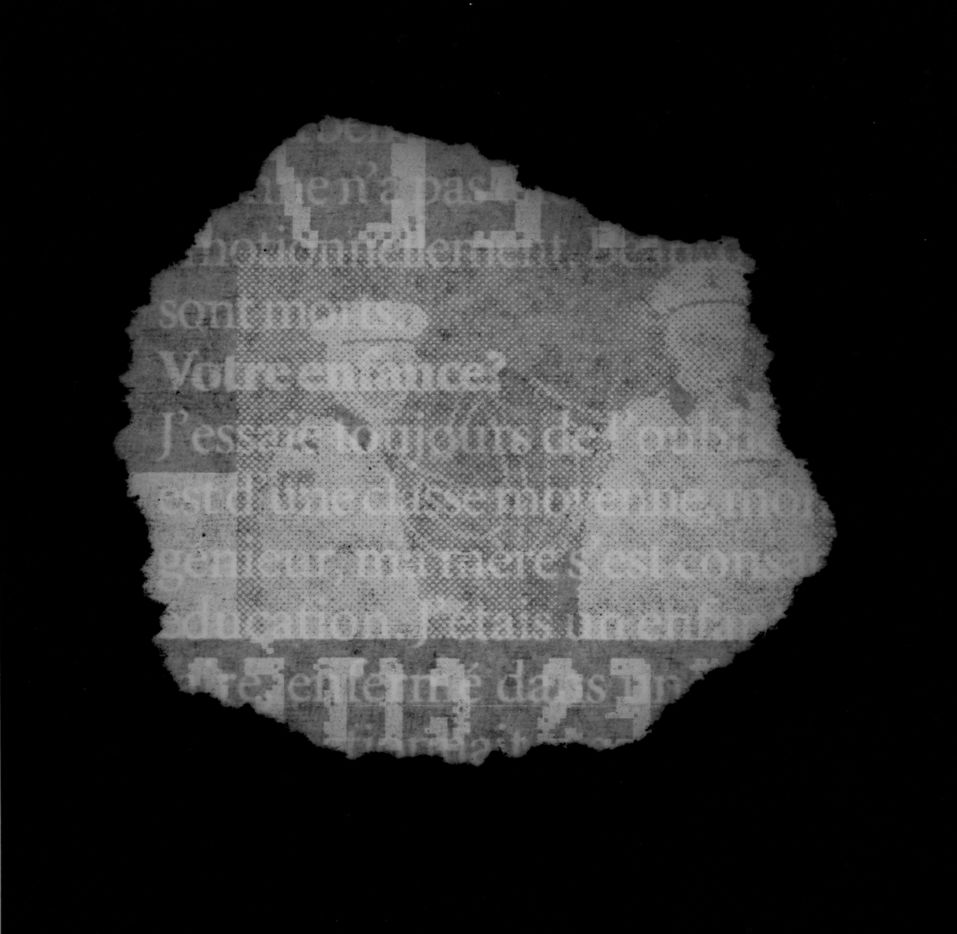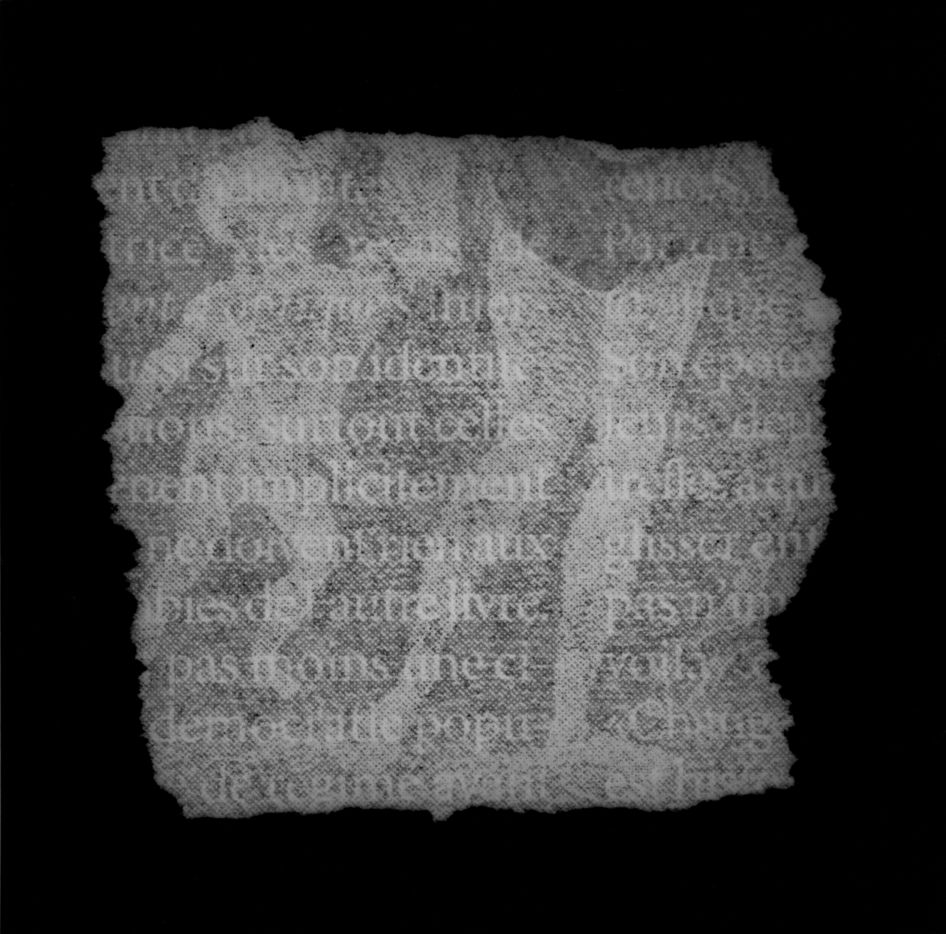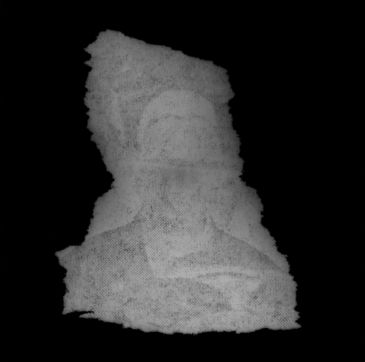Pour accéder à la série en entier, vous devez vous logger ou demander un compte Hans Lucas en cliquant ici.
Filigrane mat
Vous avez d'abord là une collection de fragments de quotidien, en vestiges archéologiques, posés sur une sorte de velours noir, mais plus noir encore, sombre au point qu'on ne sait plus si des bouts de parchemins improbables s'y enfoncent ou s'en relèvent.
Il y a donc cette exposition. Mais, rapidement, on s'intéresse aussitôt aux trouvailles de ce gisement nouveau dans le travail de Lionel Fourneaux qui, depuis des années, constitue une oeuvre photographique authentique et continue sans presque plus jamais " prendre " de photographies. Il expose des images déjà prises (par lui ou d'autres en conjonction avec d'autres éléments, textuels pour la plupart) à des traitements qui les altèrent, les métissent, et qui révèlent en elles des images prisonnières.
Nous connaissions, bien entendu, l'ambiguïté, fondamentale de l'icône, et la consubstantielle multiplicité de l'image, mais Lionel Fourneaux va bien au-delà et explore d'autres dimensions. Dans la série qui nous occupe, il s'agit du gisement imaginaire pris dans l'épaisseur du papier journal. Qui l'eût dit que l'opacité du papier d'un quotidien dissimulait une sorte de dialectique complexe et aléatoire entre texte, image, transparence et texture redoublant la logique plus profonde encore du quotidien, de l'actualité et de l'archive, sans parler du dédale entre l'aspect public du journal avec l'usage " intime " qui en est fait ici.
Produites à l'agrandisseur, utilisant le journal comme un film négatif projeté sur le papier du tirage, ces images nous apparaissent comme une image négative (ou même comme une plaque daguerréotype négative, tant la matérialité du support absorbe les contrastes des formes). Mais elle revient en fait de plusieurs renversements qui ont laissé des traces : image photographique (négatif + positif), gravure, plaque, impression, et dans l'opération de l'artiste ici : les deux envers au même endroit. Voltes faces auxquelles s'ajoutent les retournements d'instances plus proprement journalistiques : l'information, l'illustration, l'image de reportage, le texte - article et légende -, sont eux-mêmes pris d'un tournis dans la palinodie en jeu qui fait que l'ensemble, pourtant immobile comme une tablette cunéiforme, est comme la persistance rétinienne d'un derviche tourneur rêvant éveillé de morceaux extasiés de la bande de Môbius.
Il faudrait parler plus longuement des implications de ce résultat créateur qu'on pourrait appeler "l'extase du quotidien " mais contentons-nous de ceci que Lionel Fourneaux lui a donné un nom étrange : " filigrane mat", ce qui signifie qu'un fil à grain non brillant (les italiens qui nous ont appris la technique du filigrane, plaçait des petits grains dans le fil qui courait dans la matière du papier), nous conduit dans le quotidien si on le regarde par sa texture. Ajoutons que le grain est le principe et l'ultime de toute photographie, là où elle commence et où elle finit. Le grain, c'est le lieu même de l'archive photographique ; depuis toujours, et c'est en cela que le travail de Lionel Fourneaux ouvre des voies nouvelles d'exploration de l'image photographique, la photographie est un site archéologique à venir.
Ou plutôt, elle porte à la fois son archéologie (les strates de ce qu'elle archive) et son extase, sa transparence avec, entre elles, tous les degrés d'opacité, de trame, de fusion, tous les contrats sourds entre les ombres et la lumière, le déclaré et le celé, l'apparent et le disparu, l'effacé, et le revenant. Il nous fallait une langue pour refaire le chemin de ce labyrinthe : il est possible que ce soit précisément cela qui soit en question ici : le quotidien, le nôtre et le journalistique, n'est-ce pas cette hantise d'obscurités passées qui avancent à la lumière, cet oubli qui prend de l'avance sur la mémoire, ce négatif et positif retournés l'un sur l'autre et tenus de faire avec tout le reste... Un fil d'Ariane pour l'on ne sait quelle obscure vision d'avenir : un filigrane mat...
Bernard Cier, 2000.
Filigrane mat
First, you have a collection of fragments of daily life, archaeological remains, laid on a kind of black velvet, but even blacker, darker to the point that we no longer know if bits of improbable parchment are sinking in or rising up.
So there is this exhibition. But, quickly, one becomes interested in the findings of this new deposit in the work of Lionel Fourneaux who, for years, has constituted an authentic and continuous photographic work without almost ever "taking" photographs. He exposes images already taken (by him or others in conjunction with other elements, textual for the most part) to treatments that alter them, mix them, and reveal in them imprisoned images.
We know, of course, the ambiguity, fundamental of the icon, and the consubstantial multiplicity of the image, but Lionel Fourneaux goes far beyond and explores other dimensions. In the series we are dealing with, it is the imaginary deposit taken in the thickness of the newspaper. Who would have said that the opacity of the paper of a daily newspaper conceals a sort of complex and random dialectic between text, image, transparency and texture, redoubling the deeper logic of the daily newspaper, of current events and of the archive, not to mention the maze between the public aspect of the newspaper and the "intimate" use that is made of it here.
Produced with an enlarger, using the newspaper as a negative film projected on the paper of the print, these images appear to us as a negative image (or even as a negative daguerreotype plate, so much the materiality of the support absorbs the contrasts of the forms). But it returns in fact of several reversals which left traces: photographic image (negative + positive), engraving, plate, impression, and in the operation of the artist here: the two reverse sides in the same place. Flip sides to which are added the reversals of instances more properly journalistic: the information, the illustration, the image of reportage, the text - article and caption -, are themselves taken of a whirling in the palinody in play that makes that the whole, however motionless as a cuneiform tablet, is like the retinal persistence of a whirling dervish dreaming awake of ecstatic pieces of the band of Môbius.
It would be necessary to speak more at length about the implications of this creative result which one could call "the ecstasy of the everyday" but let us be satisfied with this that Lionel Fourneaux gave it a strange name: "matte filigree", which means that a thread with non-shiny grain (the Italians who taught us the technique of the filigree, placed small grains in the thread which ran in the matter of the paper), leads us in the everyday life if one looks at it by its texture. Let us add that the grain is the principle and the ultimate of all photography, where it begins and where it ends. Grain is the very place of the photographic archive; since always, and it is in this that the work of Lionel Fourneaux opens new ways of exploring the photographic image, photography is an archaeological site to come.
Or rather, it carries at the same time its archaeology (the strata of what it archives) and its ecstasy, its transparency with, between them, all the degrees of opacity, of weft, of fusion, all the deaf contracts between the shadows and the light, the declared and the concealed, the apparent and the disappeared, the erased, and the returning. We needed a language to retrace the path of this labyrinth: it is possible that this is precisely what is in question here: the daily life, ours and journalistic, is it not this haunting of past obscurities that advance to the light, this forgetting that takes the lead over memory, this negative and positive turned over each other and required to do with everything else... An Ariadne's thread for who knows what obscure vision of the future: a matt watermark...
Bernard Cier, 2000.
